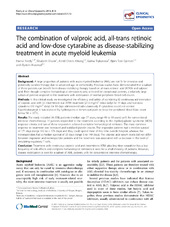| dc.contributor.author | Fredly, Hanne Kristin | en_US |
| dc.contributor.author | Ersvær, Elisabeth | en_US |
| dc.contributor.author | Kittang, Astrid Marta Olsnes | en_US |
| dc.contributor.author | Tsykunova, Galina | en_US |
| dc.contributor.author | Gjertsen, Bjørn Tore | en_US |
| dc.contributor.author | Bruserud, Øystein | en_US |
| dc.date.accessioned | 2013-09-11T12:57:20Z | |
| dc.date.available | 2013-09-11T12:57:20Z | |
| dc.date.issued | 2013-08-01 | eng |
| dc.Published | Clinical Epigenetics 5(1):13 | eng |
| dc.identifier.issn | 1868-7075 | |
| dc.identifier.issn | 1868-7083 | |
| dc.identifier.uri | https://hdl.handle.net/1956/7120 | |
| dc.description.abstract | Background: A large proportion of patients with acute myeloid leukemia (AML) are not fit for intensive and potentially curative therapy due to advanced age or comorbidity. Previous studies have demonstrated that a subset of these patients can benefit from disease-stabilizing therapy based on all-trans retinoic acid (ATRA) and valproic acid. Even though complete hematological remission is only achieved for exceptional patients, a relatively large subset of patients respond to this treatment with stabilization of normal peripheral blood cell counts. Methods: In this clinical study we investigated the efficiency and safety of combining (i) continuous administration of valproic acid with (ii) intermittent oral ATRA treatment (21.5 mg/m2 twice daily) for 14 days and low-dose cytarabine (10 mg/m2 daily) for 10 days administered subcutaneously. If cytarabine could not control hyperleukocytosis it was replaced by hydroxyurea or 6-mercaptopurin to keep the peripheral blood blast count below 50 × 109/L. Results: The study included 36 AML patients (median age 77 years, range 48 to 90 years) unfit for conventional intensive chemotherapy; 11 patients responded to the treatment according to the myelodysplastic syndrome (MDS) response criteria and two of these responders achieved complete hematological remission. The most common response to treatment was increased and stabilized platelet counts. The responder patients had a median survival of 171 days (range 102 to > 574 days) and they could spend most of this time outside hospital, whereas the nonresponders had a median survival of 33 days (range 8 to 149 days). The valproic acid serum levels did not differ between responder and nonresponder patients and the treatment was associated with a decrease in the level of circulating regulatory T cells. Conclusion: Treatment with continuous valproic acid and intermittent ATRA plus low-dose cytarabine has a low frequency of side effects and complete hematological remission is seen for a small minority of patients. However, disease stabilization is seen for a subset of AML patients unfit for conventional intensive chemotherapy. | en_US |
| dc.language.iso | eng | eng |
| dc.publisher | BioMed Central | eng |
| dc.rights | Attribution CC BY | eng |
| dc.rights.uri | http://creativecommons.org/licenses/by/2.0/ | eng |
| dc.title | The combination of valproic acid, all-trans retinoic acid and low-dose cytarabine as disease-stabilizing treatment in acute myeloid leukemia | en_US |
| dc.type | Peer reviewed | |
| dc.type | Journal article | |
| dc.date.updated | 2013-09-03T11:10:46Z | |
| dc.description.version | publishedVersion | en_US |
| dc.rights.holder | Copyright 2013 Fredly et al.; licensee BioMed Central Ltd. | |
| dc.rights.holder | Hanne Fredly et al.; licensee BioMed Central Ltd. | |
| dc.identifier.doi | https://doi.org/10.1186/1868-7083-5-13 | |
| dc.identifier.cristin | 1106594 | |
| dc.source.journal | Clinical Epigenetics | |
| dc.source.40 | 5 | |
| dc.source.14 | 1 | |
| dc.source.pagenumber | 13- | |

